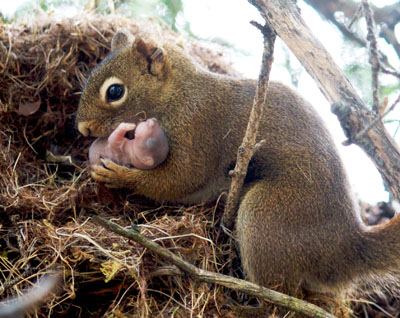What adoption in the wild tells us about the presence—and the limits—of altruism in the animal kingdom.
After climbing a tree in the middle of the Yukon forest, I looked into a squirrel’s nest and found a pup that clearly did not belong there. It was older and larger than the others in the litter. My research team and I collected DNA from the whole litter and later, back at the genetics laboratory, the mystery was solved: We determined that the larger pup had been adopted by an older sister after its mother had been killed by a predator.
Altruistic behaviors can take on many forms, even among non-human animals. For example, they may warn neighbors of nearby predators or quell a dispute between two individuals fighting one another. But perhaps the most altruistic behavior of all is to care for an orphaned offspring as though it were one of your own.

I am by no means the first researcher to discover a case of adoption in the wild. It has been observed in over 60 different species of mammals, from mice to elephants to whales. Nevertheless, adoptions in the wild are quite rare. What can explain these seemingly altruistic acts?
Animal behaviorists have been trying to understand the motivation behind altruism for decades, with little success. Some suggest that acts of kindness do not square with our Darwinian view of natural selection. Others argue that animals are simply compassionate creatures, willing to help others even while incurring a cost to themselves.
Darwin’s law of natural selection, however, states that only the individuals who are most fit for their environment pass on their genes to the next generation. The “evolutionary game” is to increase copies of your genes at the expense of those of other individuals.
Adoption, then, does not seem to make sense under this law: By adopting another female’s offspring, you are passing on her genes instead of your own. In addition, you might be putting your own offspring at risk by having one more mouth to feed. Why, then, would a female choose to raise another female’s offspring?
My own research on North American red squirrels, a species known to be non-social, has shown that adoption can indeed be explained by Darwinian evolution. My findings challenge rather simplistic notions of animals as being either “selfish” or “altruistic.” Instead, our research suggests that selfish and selfless behaviors are often deeply, perhaps paradoxically, intertwined.
My colleagues and I have found that red squirrels do not treat all orphaned young equally. In fact, we found that red squirrels never adopt unrelated orphans but do adopt related orphans as long as they are related closely enough for the benefits of adoption to outweigh the costs. Relatives share a portion of their genes; the more closely related they are, the higher the proportion of genes shared. Adopting a relative means the surrogate female is helping to pass on the genes she has in common with her relative.
But there’s a catch: While females adopt relatives to increase the copies of their genes, adding additional young may reduce the rest of the litter’s odds for survival. Indeed, we discovered that surrogate females do in fact become more selective when they have more mouths to feed. That is, as her litter size increases, she requires that orphans be a closer relative to her before she’ll adopt them.
For example, if a female already has two pups, then she might adopt her niece or nephew. But when she has three pups, she would only adopt her grandchild or younger sibling, as they share more genes than her niece or nephew would.
Females, then, are forced to calculate the costs and benefits of adoption in a sophisticated way: They only adopt when the proportion of shared genes is high enough to make up for lowering the odds for survival of their young.
This suggests that what looks like altruistic behavior at first glance may not in fact be purely altruistic. If squirrels simply adopt to “be nice,” why do they not adopt unrelated orphans? By adopting only orphans related to themselves, red squirrels force us to consider that perhaps being nice may simply be a selfish means to increase one’s genetic fitness. Essentially, you can pass on your genes by having young of your own or by helping your relatives raise their young.
What about humans? Adopting children is popular in our culture and the majority of adoptions are between unrelated individuals.
Our human ancestors lived in small clans, where adoptions were most likely to have occurred between related individuals. Human nature is defined by our complex social interactions and strong emotional bonds.
Today, most couples who adopt children do so for a multitude of reasons. However, what motivates us to adopt an unfamiliar child remains unclear. Are we altruistically trying to offer another human being different opportunities in life, or are we selfishly filling an instinctual need to raise a child? Do we feel good about ourselves simply by knowing we helped someone in need or because we are seen as generous by others?
I would wager that adoptive parents maintain that they adopted in order to improve their child’s welfare. But how do we separate feelings of pride in our children from pride in ourselves for raising wonderful children? Perhaps we are simply programmed to pass on our genes by raising children and doing so gives us feelings of joy. Indeed, these feelings of joy might be essential to motivating us to become parents and sustain our species.
This does not suggest that compassion and altruism are an illusion. But it does suggest that they arise for complicated reasons. Ultimately, the underlining motivation of these behaviors, and the reasons for their persistence, may be due to a mixture of selfish and altruistic tendencies—tendencies that ensure the survival of our genes.






Leave a reply